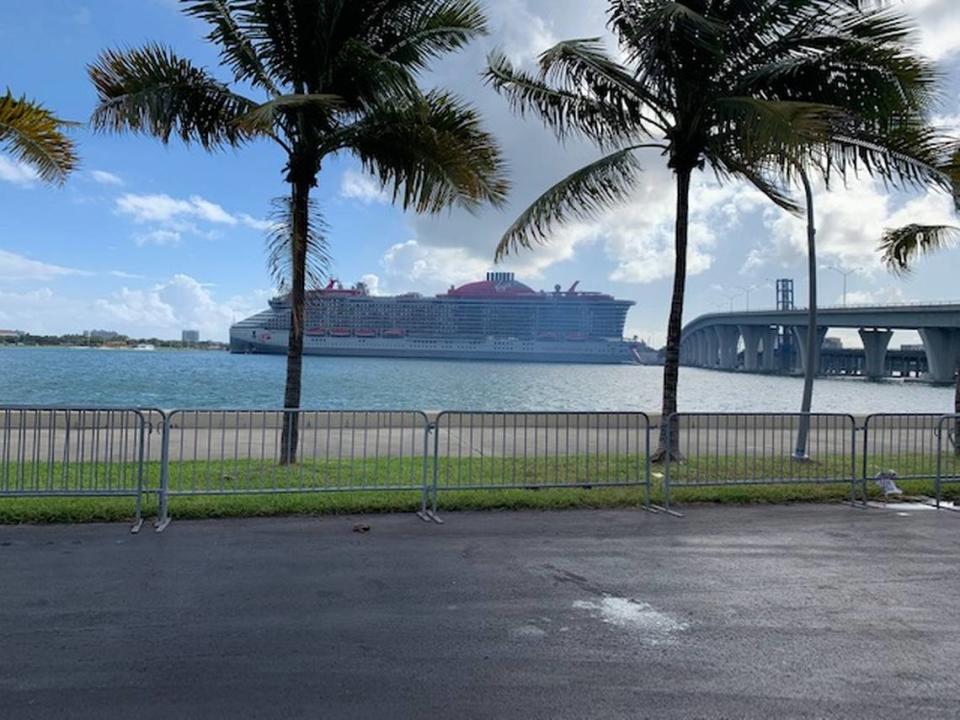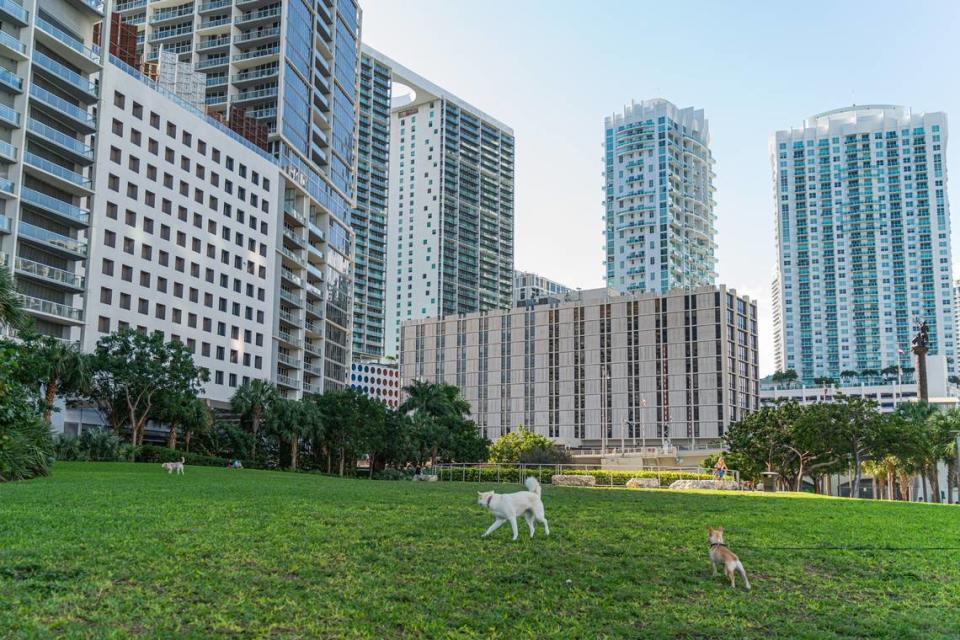We followed up on Miami’s broken promises. Here’s what we found | Opinion
- Oops!Something went wrong.Please try again later.
Remember that “new, world-class waterfront park” behind the Miami Heat arena that was promised to the people of Miami 27 long years ago? There’s finally an effort to actually make it happen, or at least some version of it. But it’s still dependent on Miami-Dade County politicians and the Heat.
Parcel B
Back in 1996, voters were sold the idea for a tiny sliver of a park on the downtown waterfront as part of a deal that allowed the basketball team, owned by billionaire cruise-line magnate Micky Arison, to build its facility in a prime spot: taxpayer-owned real estate right on Biscayne Bay. The Heat’s new coach at the time, Pat Riley, even put his credibility on the line, telling voters in advertisements that the park would be “for all of us to enjoy.”
Not only did that not turn out to be true, but the land pretty much became a spot for VIP parking and event staging by the team instead. Talk about disrespecting voters.
Now, though, there is an actual draft of a plan for the park, put together by the county after a downtown residents’ organization surveyed its members about their preferences for the new green space. County leaders said in late August that a contract to build the park — known as Parcel B or Dan Paul Plaza — could be drawn up as soon as this fall. It would then go before county commissioners for approval.
That must happen without delay. The people of Miami have waited almost three decades for the county and the team to make good on their promise. And yet the county commissioner in whose district the park would fall, Keon Hardemon, did not respond to repeated attempts by the Editorial Board to discuss whether he even supports the draft plan. That’s not a good sign. He should be leading the charge to make this long-delayed promise a reality.

The failure to build the park was part of the Miami Herald Editorial Board’s Broken Promises series, which won the 2023 Pulitzer Prize for editorial writing. We asked the question: What happens to a community when no one is held accountable for long-term civic promises? The unfortunate answer is that a lack of regard for voters leads to cynicism, a reluctance to invest in the community and a sense of disengagement.
Miami leaders say ad nauseam that they want it to be a world-class city. That starts with an engaged populace. Routinely and repeatedly breaking promises to the people ultimately dooms that effort.
And there have been so many other broken promises in addition to Parcel B. We examined a handful last year: the failures to create economic revival in a historic Black neighborhood; to construct a new Metrorail line to reach Black residents who have traditionally been shortchanged; to restore an abused 1,000-acre island off the coast of Miami; and to preserve precious archaeological sites along the Miami River that are older than ancient Rome.
Those promises have all been postponed, broken, ignored, pushed off — often for decades, as we wrote in the series. As we said then, our leaders must be held accountable, even if they were not the ones in office when those promises were made.
On the bayfront park, county leaders have been working in recent months with the Downtown Neighbors Alliance, which sent out a survey to some of the 30,000 people who now live downtown. The survey, which the county is using to help draft plans for the park, indicated residents want a mostly passive green space, with a small playground, a botanical garden, lights along the sea wall, maybe some public art or a kayak launch, plus a walking track.
It’s not exactly the bayfront soccer fields that Riley and others promised in 1996 but, after all this time, we’ll probably take it, especially because it would be the result of current residents’ input. The Heat would still get a substantial concession under this plan, which would allow the team to keep some parking and a staging areas close to the arena, while the area near the waterfront would be developed into the park. The county is negotiating with the Heat about a “substantial” financial contribution toward the park construction.
We hope it’s a lot. The team has had the benefit of taxpayer-owned land for their arena since 1999 — a whopping 24 years.
Jimmy Morales, chief operations officer for Miami-Dade County, told the Editorial Board the park could cost between $5 million and $6 million, and that negotiations are continuing. The Heat, by the way, was valued at about $3 billion in 2022 — that’s billion with a “B.”
Morales said he believes the park plan is moving forward, at long last. “I think we’re making progress. I’d love to get this wrapped up by the end of the year,” he said.
That’s probably optimistic, maybe even wildly so. Politics on the County Commission will no doubt interfere. And yet this is further along than we have gotten before. Is this finally something that beaten-down taxpayers can actually believe in?
Tequesta Circle
In the 10 months since the “Broken Promises” series of editorials ran, there has been progress in other areas, too, though not much. There’s been yet another round of discussions between the city of Miami and a developer regarding the preservation of two tiny portions of a Tequesta Indian settlement on the north bank of the Miami River at the MetSquare development. HistoryMiami Museum is reviewing preliminary drawings of the areas that are supposed to be on display to the public.

Natalia Crujeiras, CEO and executive director of HistoryMiami, told the Editorial Board in mid-September that plans call for a gallery containing the Tequesta circle with a walkway around it, and that the gallery will “highlight a section of the foundation from Miami’s first major hotel, The Royal Palm, providing an opportunity for visitors to observe the different layers of history that have accumulated at this site.”
Preservationists are hoping the project, which is supposed to include display of a second circle, could be completed in 18 months, according to Scott Silver, attorney for the Dade Heritage Trust. “It looks like we are on track to get this done,” he said.
HistoryMiami, though, wouldn’t put a timetable on completion yet. This project has been promised since 2014. The property has long been developed. And yet taxpayers just have to wait — and for how long?
Virginia Key
The restoration of Virginia Key, a long abused island off Miami’s coastline that some say could be a waterfront version of Central Park, is progressing even more slowly. The county’s $21 million plan to cover the old Virginia Key dump is on track, the county said. That’s one piece of the problem that is getting fixed, bit by bit, though it’s kind of hard to tell.
But there’s also the city’s Virginia Key Beach Park Trust. That’s the group overseeing development of a taxpayer-funded, $20 million Black history and civil rights museum that is supposed to be built at the historic Black beach on the island. Voters were promised the museum almost two decades ago, when they approved a bond issue to pay for it.
Last year, the Miami City Commission unceremoniously ousted the whole board and replaced its members with the five city commissioners, plus two members of the community. Commission Chairwoman Christine King told us then that she had no doubt the Trust would be farther along a year later. Well, here we are, and that’s debatable. There have been preliminary meetings for the past two months. King has met with members of the community to hear what they want the museum to include. Consultants have been hired and are working to come up with a plan on how to best spend the $20 million.
At the community meeting a week ago, King — who seems to be taking her responsibility seriously — said she heard the people: “They want a museum in the space, not a narrative to be whitewashed in any way. . . . They don’t want to see another 20 years go by.”
Neither do we.
Coconut Grove
In Coconut Grove, there are no real signs of a slowdown in the erasure of the city’s Black history by predatory developers, who buy up our past, one bungalow at a time. The largely Bahamian neighborhood called the Black Grove or West Grove was settled before Miami was even a city and is now under assault by economic forces. Miami Commissioner Sabina Covo, who has represented much of the Grove for the past few months, said she is working to reinvigorate some of the traditions of the Black Grove. A Bahamian heritage museum may be in the works. She knows Grand Avenue, once the heart of the community, badly needs attention and that affordable housing also is sorely needed.
There are other ideas under discussion, too, such as adding “accessory dwelling units” — essentially tiny homes or granny flats — to back yards to allow multiple generations to remain in place, slowing the drain of long-time residents.
It’ll take serious leadership for a sustained period to make a real difference in the Grove. Covo is running for reelection in November. Whoever wins the seat must tackle this problem before any more of our foundational history slips away, as it has in so much of Miami.
Metrorail
And then there’s Metrorail’s North Corridor construction. The failure to build that train line extension remains a deep wound in the county’s Black community, and progress has been glacial. The county hopes to attract federal funding, which could take years. Preliminary work is being done to better position the rail extension, which would run to the northern end of Miami-Dade County, as a high-priority project, making it more likely to win coveted dollars from Washington.
In 2018, the cost estimate was $1.8 billion, and it’ll no doubt be much higher now. Still, this promise, made almost 40 years ago, must be kept to voters who, some two generations ago, put their faith in the county, voting to tax themselves for a rail line that never came. And, as we said last year, there’s an extra incentive now: The North Corridor would run to the Hard Rock Stadium, where World Cup games will be hosted in 2026.
Public officials in this town aren’t used to being held accountable over the long haul. But voters shouldn’t accept that promises made, especially those using public money or land, can evaporate when the next person is elected. If this community is ever to fulfill its promise, voters need to stand up for themselves and demand that our leaders keep their word.

